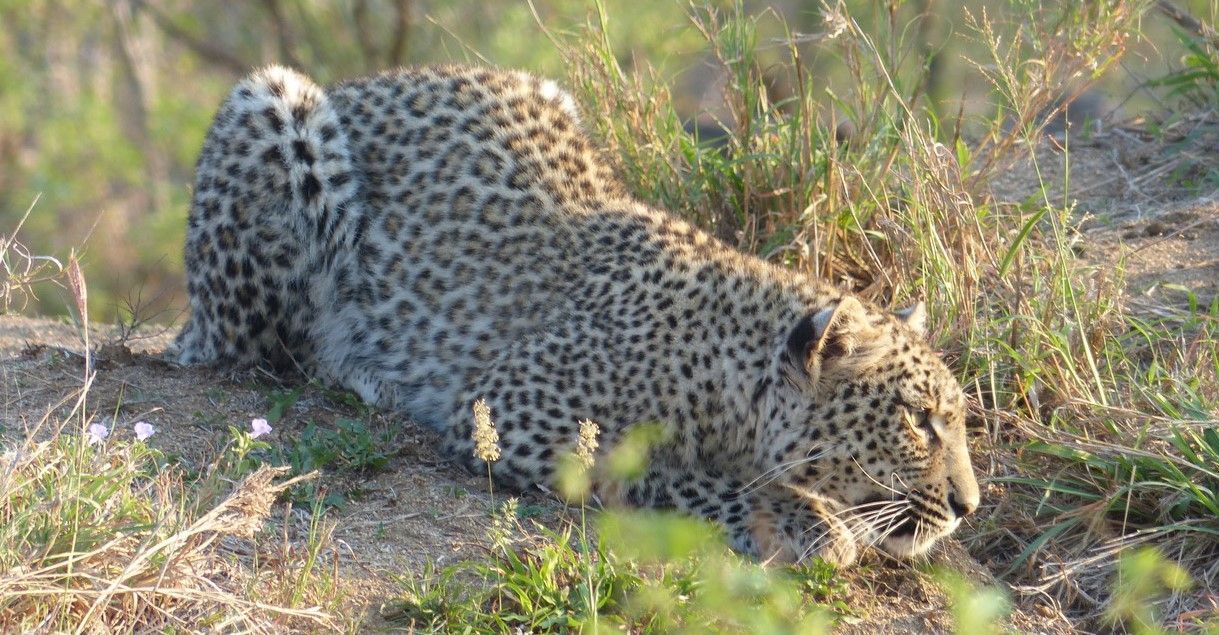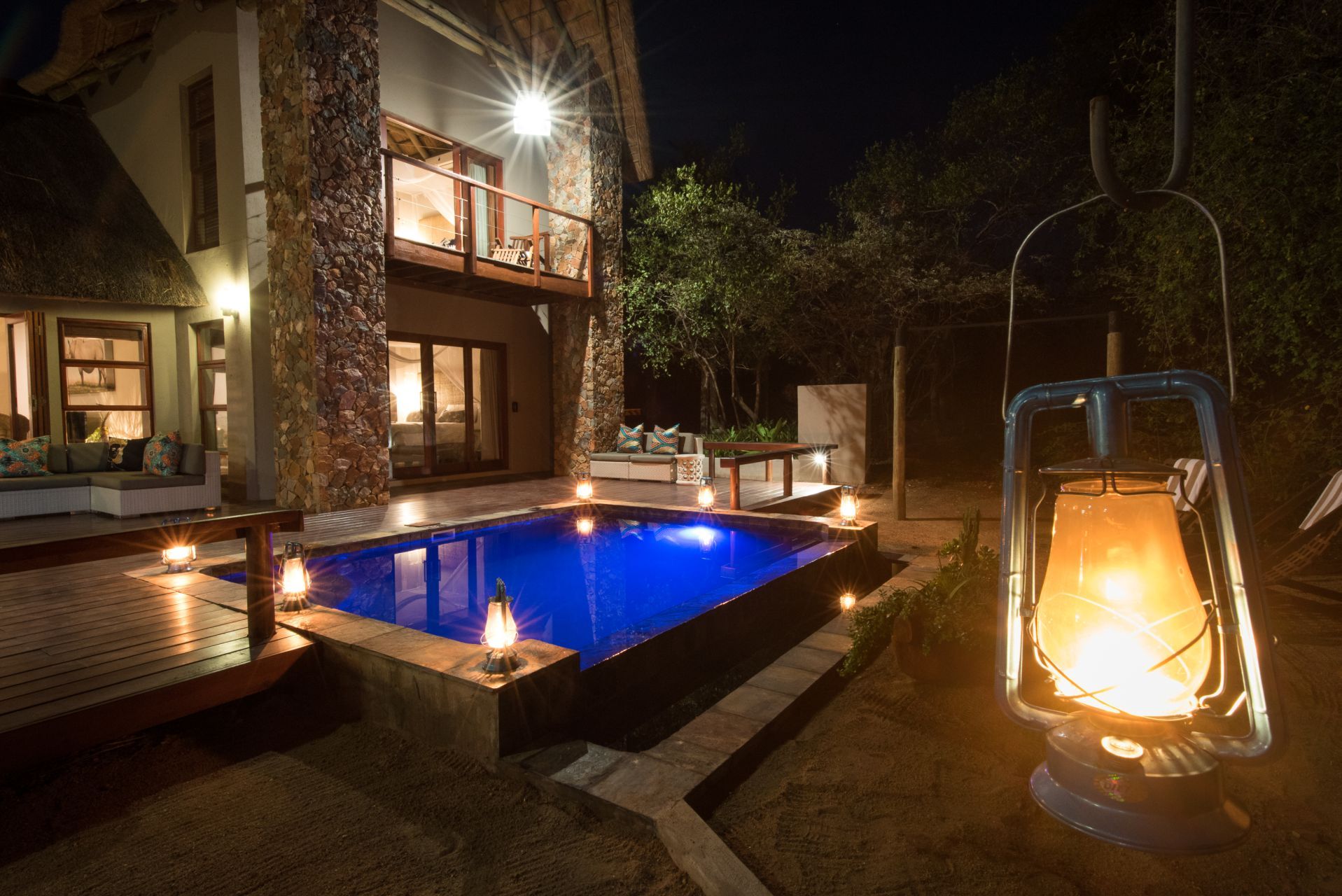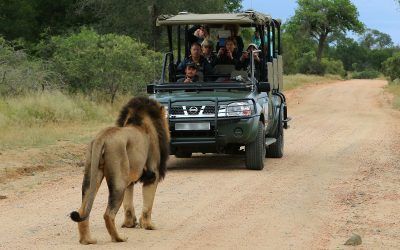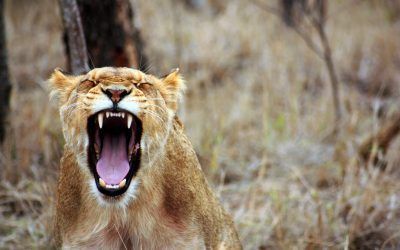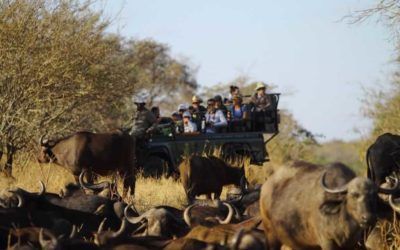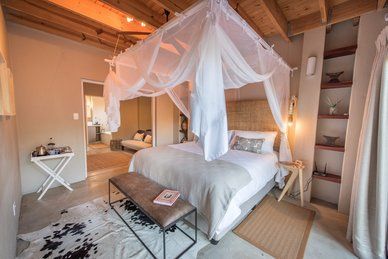Discover The Kruger Park
The Kruger National Park - All You Need to Know
You're about to set off on an unforgettable adventure through one of Africa's largest game reserves, Kruger National Park. Spanning diverse ecosystems rich in wildlife, this park offers you the chance to witness the Big Five, over 500 bird species, and breathtaking scenery. As you plan your visit, you'll need to reflect on the best times to go, how long to stay, and what activities to prioritize. With so much to see and do, it's crucial to book in advance, especially during peak seasons. But what makes Kruger truly unique, and how can you make the most of your time there?
Key Takeaways
- Diverse Wildlife: Kruger National Park is home to 147 mammal species, including the Big Five: lions, leopards, elephants, buffalo, and rhinoceros.
- Ecosystem Variety: The park features various ecosystems: savannahs, woodlands, and river systems, supporting unique flora and fauna.
- Best Viewing Times: The dry winter months (May to September) offer the best wildlife viewing opportunities, with peak tourist months in July and August.
- Accommodation Options: Ranging from budget-friendly rest camps to luxury lodges, offering diverse amenities and direct access to wildlife-rich areas.
- Guided Activities: Game drives, walking safaris, and night drives provide immersive experiences, enhancing the connection to the environment and increasing wildlife sighting chances.
A first-time guide to Kruger National Park, South Africa
In terms of accommodation, Kruger National Park offers a range of options to suit all types of travelers.
From budget-friendly rest camps to luxury lodges, you'll find something that fits your needs. Just remember to book in advance during peak seasons to guarantee availability.
Whether you're a seasoned explorer or a first-time visitor, Kruger National Park promises an enriching experience filled with breathtaking scenery and diverse wildlife.
An intoduction to the Kruger National Park
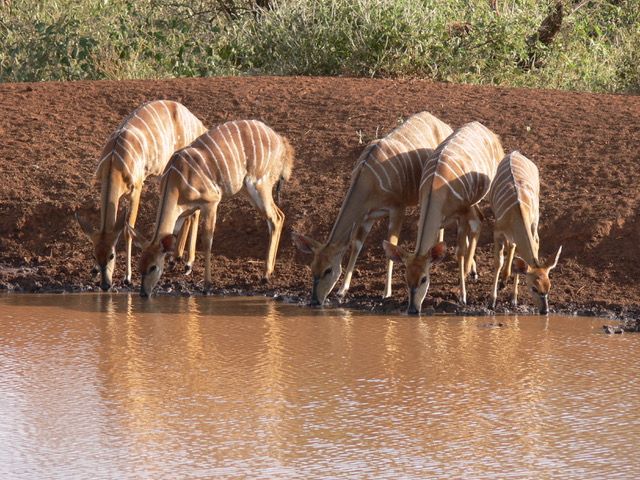
Kruger National Park, one of Africa's largest and most iconic game reserves, offers an unparalleled adventure experience.
You'll immerse yourself in breathtaking scenery and diverse wildlife, making it a haven for nature enthusiasts and adventure seekers alike. Spanning approximately 19,485 square kilometers, Kruger is renowned for its rich biodiversity, featuring 147 mammal species, including the iconic Big Five: lions, leopards, elephants, buffalo, and rhinoceros.
As you explore the park, you'll encounter over 500 bird species and a variety of ecosystems, including savannahs, woodlands, and rivers.
These diverse habitats support a wide range of wildlife, offering unique safari experiences. Whether you're on a thrilling game drive or a guided walk, you'll have the opportunity to observe various animal species in their natural habitat.
The best wildlife viewing opportunities occur during the dry winter months of May to September, when vegetation is thinner, making animal spotting easier.
With its focus on conservation and sustainable tourism, Kruger National Park is a must-visit destination for anyone looking to connect with nature and experience the beauty of Africa's wildlife.
Cultural and Historical Sites: Journeying into the Past
Beyond the thrill of wildlife encounters, an expedition into Kruger National Park's cultural and historical sites offers a profound exploration of the past.
You'll discover ancient rock paintings created by the San people, dating back over a thousand years, which provide a glimpse into the lives and beliefs of these early inhabitants. The archaeological site of Thulamela, located within the park, showcases traces of late Iron Age societies, revealing the region's historical significance and cultural heritage.
As you investigate deeper, you'll learn about the intricate relationship between indigenous communities and the land through educational programs. These programs highlight the importance of preserving natural terrains and the historical context of wildlife conservation.
Planning Your Visit: Best Times and Tips
Commence your Kruger National Park adventure by planning your visit strategically. To maximize your wildlife viewing experience, consider visiting during the dry winter months from May to September. This period offers thinner vegetation, making it easier to spot animals.
Nonetheless, it's crucial to book accommodations and activities early, especially during peak tourist months like July and August, which coincide with school holidays.
Morning and evening game drives are highly recommended as animal activity peaks during these cooler times of day. Be prepared for varying weather conditions, with summer months being hot and humid and winter nights becoming chilly.
Don't forget to pack layered clothing to guarantee comfort throughout your visit.
If you prefer lush scenery, the rainy season from October to April might be your preference, but keep in mind that it can hinder wildlife visibility. Conversely, this period is ideal for spotting newborn animals and enjoying lively scenery.
How much time should I spend in Kruger?
To make the most of your Kruger National Park adventure, it's important to reflect on how much time you should spend there. The length of your stay can greatly impact your wildlife sightings and overall experience.
Although shorter visits can still be rewarding, longer stays improve your chances of spotting a variety of wildlife and allow for exploration of quieter camps.
Here are some key points to keep in mind when planning your trip:
- Minimum Stay: Aim for at least five days to fully engage in various activities such as guided game drives and bush walks.
- Seasonal Factors: The dry winter months from May to September are ideal for wildlife viewing, with peak visitor season occurring in July and August.
- Exploration and Relaxation: Longer stays help balance exploration and relaxation, reducing the risk of safari fatigue.
- Comprehensive Experience: Think about extending your trip with side excursions along the Panorama Route or stays in private reserves to enjoy a range of accommodation options and unique wildlife experiences.
Top things to do in Kruger
You're about to experience the best of Kruger National Park.
Start by going on a game excursion, where you'll have the chance to see the Big Five and a diverse array of other animals in their natural habitat.
From there, you can take a walk in the park, go on a thrilling night excursion, enjoy the local cuisine at one of the restaurants, or explore the many places of interest that make Kruger so unique.
Go on a game drive
Early mornings in Kruger National Park are the perfect time to set out on a game excursion. The cooler temperatures make wildlife more active and visible, increasing your chances of spotting the Big Five: lions, leopards, elephants, buffalo, and rhinoceros.
Guided tours are an excellent way to explore the park's diverse habitats, including savannahs, woodlands, and river systems.
On a game excursion, you'll have the opportunity to immerse yourself in the sounds of nature and observe various animal species in their natural habitat. Experienced guides will provide insights into animal behavior, the ecosystem, and the best spots for wildlife sightings.
Here are some key points to reflect on when planning your game drive:
Best Times: Early mornings and late afternoons are ideal for game drives because of cooler temperatures.
Driving Options: Choose from self-drive, guided tours, and night drives to tailor your experience.
Guided Tours: Experienced guides improve the experience with insights into animal behavior and the ecosystem.
Prime Locations: Waterholes and rivers are prime spots for wildlife observation, especially during the dry season from May to September.
Take a walk in the park
Walking safaris in Kruger National Park offer an unparalleled opportunity to immerse yourself in the park's diverse ecosystems. By joining a guided walking safari, you'll experience the park in a way that's both immersive and enlightening. Expert guides will lead you through the park's varied terrains, pointing out the unique flora and fauna that call Kruger home.
As you walk, you'll have the chance to observe wildlife up close, learning about their habitats and behaviors from your knowledgeable guide. This isn't just about spotting animals, though – it's also about comprehending the intricate web of life that sustains them.
You'll discover the park's hidden gems, from the tiniest insects to the majestic trees that provide shade and shelter. Guided walking safaris are a great way to improve your wildlife viewing experience in Kruger.
By exploring the park on foot, you'll gain a deeper appreciation for the natural world and the creatures that inhabit it. So why not lace up your hiking boots and take a walk in the park? You won't regret it.
With expert guides by your side, you'll uncover the secrets of Kruger's incredible ecosystems.
Go on a Night Drive
Night drives in Kruger National Park are a thrilling way to experience the park's nocturnal wildlife. You'll have the chance to see predators like lions and leopards, which are more active after sunset.
These drives typically last around two to three hours, providing you with the opportunity to utilize spotlights to uncover hidden wildlife behaviors and interactions in the dark.
Guided by experienced rangers, you'll gain valuable insights about the park's ecosystems and the animals you encounter during the excursion. Wildlife activity during night drives can reveal a different perspective of the park, showcasing animals such as hyenas, bushbabies, and various owl species that aren't commonly seen during daytime safaris.
Here are some key points to take into account for your night drive:
Duration: Night drives last approximately 2-3 hours.
Guided Experience: Experienced rangers lead the drives, offering expert insights into the park's nocturnal wildlife.
Wildlife Encounters: Expect to see nocturnal animals like lions, leopards, hyenas, and owls.
Booking: It's advisable to book night drives in advance, especially during peak seasons, to guarantee availability and improve your safari experience.
Enjoy the restaurants
Plunge into the culinary delights of Kruger National Park by exploring the variety of dining options available within its rest camps. You'll discover restaurants that serve traditional South African cuisine, offering buffets or à la carte menus that cater to diverse tastes. Enjoy meals as you overlook scenic views of the surrounding wildlife and vistas, making every dining experience unforgettable.
Many rest camps, such as Lower Sabie and Skukuza, have shops that offer self-catering options with groceries and supplies for visitors preferring to prepare their meals. This flexibility allows you to choose between dining out or cooking in, ensuring that your culinary needs are met.
Dining experiences in the park often incorporate local flavors and ingredients, allowing you to taste authentic dishes unique to the region. To secure dining options, especially in more popular camps, it's recommended to make reservations during peak seasons.
Whether you're in the mood for a casual meal or a more formal dining experience, Kruger National Park's restaurants have something for everyone.
Explore the places of interest
After savoring the culinary delights of Kruger National Park, it's time to explore the park's vast and diverse terrains. Your safari adventure awaits, filled with thrilling wildlife encounters and breathtaking vistas.
If you are like us and a lover of Elephants do not miss the Elephant Museum at Letaba, its an absolute must see.
Kruger is renowned for the Big Five, offering ample opportunities to spot these iconic animals during guided game drives and tours.
You'll venture through diverse ecosystems, including savannahs, woodlands, and river systems, which support rich biodiversity and offer unique wildlife viewing experiences throughout the year.
Here are some top activities to add to your itinerary:
Early Morning Game Drives: Start your day with an early morning game drive to catch the peak animal activity, especially during the dry season from May to September.
Guided Walks: Set off on a guided walk to explore the park's flora and fauna up close, gaining a deeper connection to the environment.
Night Drives: Experience the nocturnal wildlife behavior on a night drive, offering a unique perspective on the park's inhabitants.
Birdwatching: With over 500 bird species recorded, Kruger is a paradise for bird enthusiasts looking to spot a variety of birds in their natural habitats.
Experiencing the Big Five in Kruger
Lions: Head to Satara and Lower Sabie for evening hunts, where lions are frequently spotted.
Elephants: Visit Letaba waterholes to observe these majestic animals up close, learning about their social behaviors and interactions.
Rhinoceros: Explore the southern areas of the park with guided tours, increasing your chances of a successful sighting.
Buffalo: Venture into the central bushveld to witness buffalo herds grazing in open areas, contributing to the rich biodiversity that makes Kruger a premier safari destination.
Leopard: Good luck they can pop up anywhere, remember they are cats its all on their terms...
With guided tours and strategic planning, you'll be well on your way to experiencing the Big Five in Kruger National Park, creating unforgettable memories amidst the stunning African wilderness.
Kruger's Diverse Ecosystems
You're about to explore the diverse ecosystems of Kruger National Park, where varied terrains support a rich fabric of wildlife.
The park's ecosystems include savannah grasslands, mopane woodlands, riverine forests, acacia thickets, and baobab sandveld, each providing unique habitats for different species.
As you venture into these ecosystems, you'll discover how they interconnect to create the park's remarkable biodiversity.
Savannah Grasslands
Here are some key aspects of the savannah grasslands:
Diverse Herbivores: Zebras, wildebeests, and elephants are just a few of the many herbivores that call the savannah grasslands home.
Predator Habitat: The abundance of prey species makes the savannah grasslands a perfect hunting ground for predators like lions, cheetahs, and hyenas.
Seasonal Migration: The dry months bring herds together near water sources, enhancing wildlife viewing opportunities.
Biodiversity: The grasslands support a variety of flora and fauna, including tall grasses, flowering plants, and various bird species.
Mopane Woodlands
As you explore the diverse ecosystems of Kruger National Park, the Mopane Woodlands stand out as a unique and fascinating environment. You'll find yourself immersed in a world dominated by the Mopane tree, which forms the backbone of this ecosystem. The northeastern regions of the park are particularly renowned for these woodlands, which support a diverse array of wildlife.
You'll have the chance to observe a variety of herbivores, including elephants and giraffes, feeding on the nutritious leaves of the Mopane tree. Predators like lions and leopards likewise call this habitat home, preying on the herbivores that roam the woodlands.
The Mopane Woodlands play a vital role in the park's biodiversity, providing habitat for over 147 mammal species and numerous bird species that thrive in this environment. Seasonal changes bring lively colors, with the trees turning yellow and red during the dry season, attracting wildlife and enhancing the visual appeal of the scenery.
The nutrient-rich soil supports a variety of plant species, creating a complex ecological network that contributes to the overall health of Kruger National Park's ecosystems.
Riverine Forest
Riverine forests in Kruger National Park offer a stark contrast to the Mopane Woodlands, with lush vegetation and a diverse array of flora and fauna plunging along the banks of rivers and watercourses.
As you explore these ecosystems, you'll discover significant habitats for various wildlife species, including birds, mammals, and reptiles, thriving in the moisture-rich environment.
The riverine forest is a crucial corridor for animal movement, particularly for elephants and other large herbivores that rely on the water sources for sustenance.
Birdwatchers can enjoy sightings of specialized avian species such as fish eagles and kingfishers, which are commonly found in these lush habitats owing to the abundance of food resources.
Key Features of Riverine Forests in Kruger National Park:
Diverse Flora: Common tree species include willow trees, jackalberry, and sycamore fig, contributing to the dense canopy that supports numerous animal species.
Significant Habitats: These ecosystems provide essential habitats for various wildlife species, including birds, mammals, and reptiles.
Crucial Corridors: Riverine forests serve as vital corridors for animal movement, particularly for elephants and other large herbivores.
Birdwatching Opportunities: Specialized avian species such as fish eagles and kingfishers are commonly found in these habitats owing to the abundance of food resources.
Acacia Thickets
During the exploration of Kruger National Park's diverse ecosystems, you'll encounter Acacia thickets, which are characterized by dense clusters of acacia trees that provide significant cover and habitat for numerous wildlife species.
These thickets are a haven for browsers like giraffes and kudu, offering them fundamental shelter and food sources. The rich biodiversity within these ecosystems is astounding, with over 200 species of trees, shrubs, and herbaceous plants thriving in the nutrient-rich soil.
As you venture into these thickets, you'll notice how they serve as pivotal breeding grounds for various bird species. Nesting raptors and numerous songbirds rely on the thicket's shelter and food sources, making them a critical component of the park's ecological balance.
The acacia thickets likewise act as corridors for larger species moving between habitats and offer refuge to smaller mammals. Seasonal changes in the thickets influence wildlife behavior, with animals congregating around water sources during the dry season and the lush greenery in the wet season supporting increased herbivore populations.
Exploring these ecosystems provides a unique opportunity to observe the intricate relationships between wildlife and their habitat, showcasing the park's remarkable biodiversity.
Baobab Sandveld
The Baobab Sandveld, another fascinating ecosystem within Kruger National Park, offers a stark contrast to the dense Acacia thickets. Here, you'll find yourself surrounded by iconic baobab trees, some of which are believed to be over a thousand years old.
These natural wonders store large amounts of water in their trunks, making them a crucial source of sustenance for the park's diverse wildlife. As you explore this unique ecosystem, you'll have the opportunity to witness large herds of elephants foraging for the nutritious fruit of the baobab tree.
The open plains, interspersed with dense thickets, provide habitats for various antelope species and predators like lions and leopards that hunt in the area.
Key Features of the Baobab Sandveld:
Diverse Bird Species: The Baobab Sandveld is home to a variety of bird species, making it an excellent location for birdwatching, especially for spotting the rare and colorful Lilac-breasted Roller.
Seasonal Changes: The dry season offers the best opportunities for viewing animals as they congregate around remaining water sources.
Unique Terrain: The terrain features open savannahs and dense thickets, providing a diverse range of habitats for wildlife.
Wildlife Viewing: The Baobab Sandveld supports a variety of wildlife, including large herds of elephants and various antelope species, offering unparalleled opportunities for wildlife viewing.
Wooded savanna on shale
Deep within Kruger National Park, you'll find yourself immersed in the wooded savanna on shale, a unique ecosystem that seamlessly blends open grasslands with scattered trees.
This habitat is a haven for various wildlife species, offering a mix of acacia and marula trees that are essential for herbivores such as elephants and kudu. The shrub layer provides nesting sites and food resources for numerous bird species, making it a birdwatcher's paradise.
As you explore this ecosystem, you'll notice how predators like lions and leopards take advantage of the cover provided by the trees to stalk their prey.
The rich biodiversity found in the wooded savanna on shale contributes considerably to the overall health of the park, playing a fundamental role in ecological balance and conservation efforts.
By experiencing this ecosystem firsthand, you'll gain a deeper appreciation for the intricate relationships between the flora and fauna that call Kruger National Park home.
The wooded savanna on shale is a reflection of the park's diverse ecosystems and the importance of preserving such natural wonders.
How do I book a visit to Kruger?
Booking a visit to Kruger National Park is straightforward and can be done through the South African National Parks (SANParks) website. You can choose from a variety of accommodations, ranging from luxury lodges to self-catering camps, and book activities such as guided game drives.
To guarantee a smooth booking process, consider the following steps:
Plan Ahead: Book your accommodations and activities well in advance, especially during peak times like July and August, to avoid availability issues.
Check Availability: Use the SANParks website to check availability for specific dates and select your preferred room configurations.
Understand Fees: Note that daily conservation fees apply for entry into the park: R486 ($27) for adults and R100 ($5) for South African residents.
Optimal Visiting Times: Visit between May and September for better wildlife visibility, as this is the dry season with thinner vegetation.
You can also book your Kuger stay through us. We have direct contact with Kruger at all times and can offer you the same or better rates than Kruger does directly.
Experience the Kruger from Ekhaya Bush Villa
As you finalize your booking and prepare for an unforgettable adventure in Kruger National Park, consider elevating your experience with a stay at Ekhaya Bush Villa. This luxurious accommodation offers direct access to the park's wildlife-rich areas, ensuring that your safari adventure is nothing short of extraordinary.
At Ekhaya Bush Villa, you'll enjoy spacious and comfortable living arrangements, complete with private amenities that provide a tranquil retreat after a day of exploring the park.
The villa's strategic location allows for easy access to various safari activities, including guided game drives, walking safaris, and birdwatching excursions. You can immerse yourself in the sounds of the African bush, with opportunities for wildlife observation right from the villa's premises.
Ekhaya Bush Villa serves as an ideal base for exploring Kruger National Park, combining comfort with the thrill of close wildlife encounters.
Whether you're on a guided game drive or simply relaxing at the villa, you'll be surrounded by the natural beauty and diverse wildlife of the park, making your experience truly unforgettable.
With Ekhaya Bush Villa, you'll have the freedom to create your own safari adventure, customized to your interests and preferences.
Frequently Asked Questions
How Many Days in Kruger Is Enough?
You'll need at least 5 days in Kruger to fully experience its wonders, allowing for multiple game drives, guided bush walks, and exploration of quieter camps, but even shorter visits can be rewarding if planned well.
What Is the Best Month to Visit Kruger National Park?
As you step into the wild fabric of Kruger National Park, May to September unfolds as the best months to visit, with July and August offering peak wildlife encounters, though October to March is ideal for birdwatching.
Is It Safe to Self Drive From Johannesburg to Kruger National Park?
You can safely self-drive from Johannesburg to Kruger National Park if you're vigilant, adhere to speed limits, and avoid driving after dark because of wildlife hazards and reduced visibility. Make certain your vehicle is reliable and fueled before entering the park.
Which Part of Kruger Is the Best to Visit?
You'll love Kruger's diverse regions, but the best part to visit depends on your interests. For the Big Five, head to the Southern region around Skukuza. For predators, visit the Central region near Satara. For a remote experience, explore the Northern region around Punda Maria.
The Iconic Kruger National Park
Navigating the vast expanse of Kruger National Park, discover the secrets of Africa's largest game reserve and what makes it a wildlife enthusiast's paradise.


Kruger Park Blog Articles
Nestled in the heart of the iconic Greater Kruger National Park, Ekhaya Bush Villa offers an unparalleled wildlife experience. Here, you can witness the majestic Big Five in their natural habitat and marvel at the park's vibrant birdlife. As night falls, embark on thrilling safaris to spot elusive nocturnal creatures. Even the smaller species of Kruger Park, often overlooked, contribute to the rich tapestry of biodiversity. Ekhaya is a haven for wildlife enthusiasts, offering a unique window into the diverse ecosystem of Kruger National Park, captivating both seasoned safari-goers and first-time visitors.



